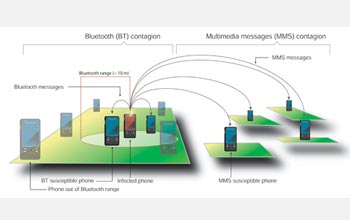All Images
News Release 09-105
Viral Epidemics Poised to Go Mobile
Scientists predict mobile phone viruses will pose a serious threat
This material is available primarily for archival purposes. Telephone numbers or other contact information may be out of date; please see current contact information at media contacts.

This image shows the different mechanisms of virus transmission between mobile phones. A Bluetooth virus can infect all phones found within Bluetooth range of the infected phone, its spread being determined by the owner's mobility patterns. An MMS virus can infect all susceptible phones whose number is found in the infected phone's address book, resulting in a long-range spreading pattern that is independent of the infected phone's physical location.
Credit: Pu Wang, University of Notre Dame, Physics
Marta C. González, Northeastern University, Physics
César A. Hidalgo, Harvard Kennedy School of Government
Albert-László Barabási, Northeastern University, Harvard Medical School and Dana-Farber Cancer Institute
Download the high-resolution JPG version of the image. (1.3 MB)
Use your mouse to right-click (Mac users may need to Ctrl-click) the link above and choose the option that will save the file or target to your computer.
This time-lapse image depicts the spreading pattern of a MMS (multimedia messaging system) mobile phone virus. Like many computer viruses, MMS viruses spread using the address book of the device. Because the users' address book often contains phone numbers of far away users, transmission of MMS viruses follows a delocalized pattern as shown here. Spread of MMS viruses is much faster than Bluetooth viruses because it is not restricted by human behavioral patterns, however current transmission of these types of viruses is constrained because the number of susceptible devices is small.
Credit: Pu Wang, University of Notre Dame, Physics
Marta C. González, Northeastern University, Physics
César A. Hidalgo, Harvard Kennedy School of Government
Albert-László Barabási, Northeastern University, Harvard Medical School and Dana-Farber Cancer Institute
This video depicts the spreading pattern of a Bluetooth mobile phone virus. Transmission of a Bluetooth virus follows a wave-like pattern, predominantly infecting users in the vicinity where the virus was released due to the fact that a Bluetooth virus can only infect Bluetooth-activated phones in a 10-30 meter radius. This simulation of infection shows that, in the absence of intervention, Bluetooth viruses will eventually infect all susceptible handsets, but the rate is slow compared to MMS viruses because spread is limited by human behavioral and mobility patterns.
Credit: Pu Wang, University of Notre Dame, Physics
Marta C. González, Northeastern University, Physics
César A. Hidalgo, Harvard Kennedy School of Government
Albert-László Barabási, Northeastern University, Harvard Medical School and Dana-Farber Cancer Institute

The researchers' finding appear in the May 22, 2009, issue of Science magazine.
Credit: Copyright 2009 AAAS
Download the high-resolution JPG version of the image. (40 KB)
Use your mouse to right-click (Mac users may need to Ctrl-click) the link above and choose the option that will save the file or target to your computer.
